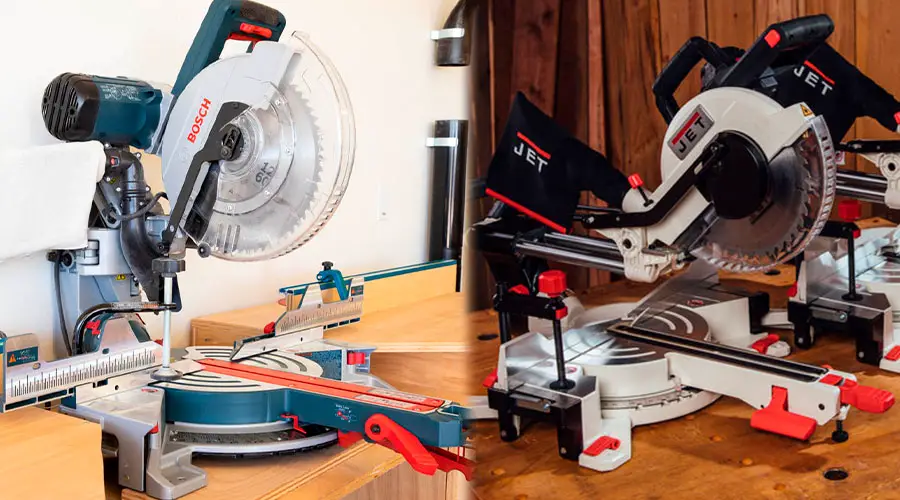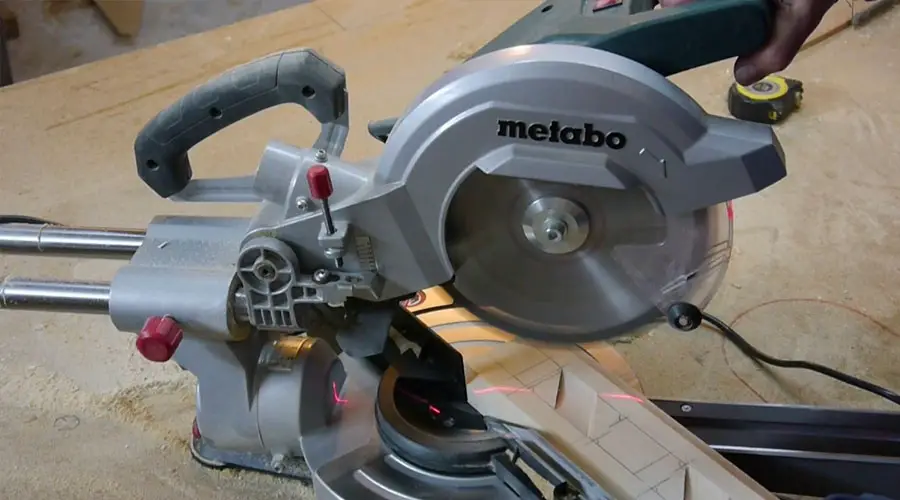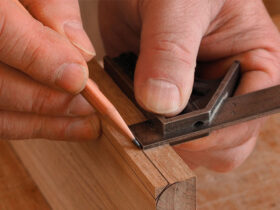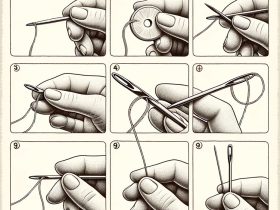Miter saws are essential power tools in woodworking and construction projects, known for their ability to make accurate angled cuts with ease and precision. These versatile tools are a must-have for professionals and DIY enthusiasts alike, as they significantly simplify tasks such as molding, framing, and cutting materials to size. In this article, we will focus on comparing the two most popular miter saw sizes: 10-inch and 12-inch models. Our aim is to provide you with valuable insights into their respective features, advantages, and drawbacks, ultimately helping you determine which miter saw size best suits your specific needs and project requirements.

Overview of 10-Inch Miter Saws
Description and specifications
10-inch miter saws are characterized by their 10-inch diameter blades, which are designed for making precise cuts on various materials. These saws typically have a lighter and more compact design compared to their 12-inch counterparts, making them a popular choice for those who prioritize portability.
Common uses and applications:
10-inch miter saws are suitable for a wide range of woodworking and construction tasks, including cutting baseboards, trim work, framing, and more. Their versatility makes them a popular choice for both DIY enthusiasts and professionals working on smaller-scale projects.
Advantages:
- Portability and weight: Due to their smaller size and lighter weight, 10-inch miter saws are easier to transport and maneuver, making them a great option for those who work on multiple job sites or have limited storage space.
- Lower cost: Generally, 10-inch miter saws are more affordable than 12-inch models, making them an attractive choice for those on a budget or new to woodworking.
- Faster blade speed: The smaller blade size of 10-inch miter saws allows for a higher RPM (revolutions per minute), resulting in faster cuts and increased efficiency.
- Availability of blades: 10-inch blades are widely available and often more affordable than 12-inch blades, allowing for easier and more cost-effective blade replacement.
Disadvantages:
- Limited cutting capacity: The smaller blade size of 10-inch miter saws limits their cutting capacity, making them less suitable for cutting larger or thicker materials.
- Not ideal for large or heavy materials: Due to their limited cutting capacity, 10-inch miter saws may struggle with larger or heavier materials, making them less suitable for heavy-duty projects.
Overview of 12-Inch Miter Saws
Description and specifications:
12-inch miter saws are equipped with larger, 12-inch diameter blades, allowing for greater cutting capacity and improved performance when working with larger materials. They are typically heavier and more robust than 10-inch miter saws, making them a preferred choice for heavy-duty applications and professional job sites.
Common uses and applications:
12-inch miter saws excel in a variety of woodworking and construction tasks, such as cutting larger pieces of lumber, handling heavy-duty framing jobs, and working with thicker materials. They are favored by professionals who require greater cutting capacity and power for more demanding projects.
Advantages:
- Increased cutting capacity: The larger blade size of 12-inch miter saws enables them to cut through thicker and wider materials with ease, making them ideal for heavy-duty projects.
- Better for larger materials and heavy-duty projects: The greater cutting capacity and power of 12-inch miter saws make them well-suited for handling larger materials and more demanding tasks.
- Higher torque for smoother cuts: 12-inch miter saws generally have higher torque than 10-inch models, resulting in smoother cuts and better overall performance when cutting denser materials.
Disadvantages:
- Heavier and less portable: Due to their larger size and increased weight, 12-inch miter saws are more challenging to transport and maneuver compared to 10-inch models. This can be a drawback for those who work across multiple job sites or have limited storage space.
- Higher cost: 12-inch miter saws are generally more expensive than their 10-inch counterparts, which may be a concern for those on a budget or new to woodworking.
- Slower blade speed: The larger blade size of 12-inch miter saws typically results in a lower RPM, meaning cuts may be slightly slower compared to 10-inch models.
- Availability and cost of blades: 12-inch blades tend to be less readily available and more expensive than 10-inch blades, which can result in higher maintenance costs over time.
Comparative Table: 10-Inch vs 12-Inch Miter Saws
To help you better understand the differences between 10-inch and 12-inch miter saws, we have prepared a comparative table highlighting the key distinctions in terms of cutting capacity, weight and portability, cost, blade speed, and torque.
| Feature | 10-Inch Miter Saw | 12-Inch Miter Saw |
|---|---|---|
| Cutting capacity | Limited (smaller materials) | Greater (larger materials) |
| Weight & portability | Lightweight & portable | Heavier & less portable |
| Cost | Generally lower | Generally higher |
| Blade speed (RPM) | Faster | Slower |
| Torque | Lower | Higher |
Factors to Consider When Choosing a Miter Saw
After reviewing the comparative table, you can delve deeper into the factors that may influence your decision when choosing between a 10-inch and 12-inch miter saw:
- Project requirements: Consider the size and type of materials you’ll be working with, the level of precision needed, and how frequently you’ll be using the miter saw. This will help you determine whether a larger cutting capacity or a lighter, more portable option is more suitable for your needs.
- Budget constraints: Take into account the initial cost of the miter saw and the ongoing expenses associated with blade replacements and maintenance. This will help you decide if a more affordable 10-inch saw or a higher-priced 12-inch model is a better fit for your budget.
- Workspace and storage limitations: Evaluate the amount of space available in your workshop or storage area. If you have limited space, a more compact 10-inch miter saw may be the better choice.
- Portability requirements: If you need to transport your miter saw between job sites or various locations, the lighter and more portable 10-inch model might be more suitable.
- Availability of replacement blades: Consider the availability and cost of replacement blades for each miter saw size. If 10-inch blades are more readily available and affordable in your area, this may influence your decision.

Tips for Getting the Most Out of Your Miter Saw
Once you’ve chosen the right miter saw for your needs, follow these tips to ensure you get the best performance and longevity out of your investment:
- Proper maintenance and blade care: Regularly clean and maintain your miter saw to ensure it operates smoothly and lasts longer. This includes inspecting the blade for damage, keeping the sawdust collection system clean, and lubricating the moving parts as needed.
- Using appropriate blades for different materials: Choose the right blade for the material you’re cutting to ensure clean, accurate cuts and prevent damage to your miter saw. There are specialized blades for cutting different materials, such as wood, metal, and plastic.
- Ensuring a safe and secure workspace: Set up your miter saw on a stable and level surface, and make sure it is securely fastened. Always use appropriate safety equipment, such as eye and ear protection, and follow the manufacturer’s guidelines for safe operation.
- Investing in useful accessories: Enhance the capabilities of your miter saw by investing in helpful accessories like a miter saw stand, dust collection system, or laser guide. These can improve the accuracy, efficiency, and overall user experience when working with your miter saw.
Conclusion
In summary, both 10-inch and 12-inch miter saws offer unique advantages and drawbacks, making each suitable for different project requirements and user preferences. By considering factors such as cutting capacity, portability, cost, and workspace limitations, you can make an informed decision about which miter saw size is best suited to your needs. Regardless of your choice, remember to maintain your miter saw properly and use appropriate safety precautions to ensure a successful and enjoyable woodworking experience.
In addition to miter saws, other saw types like Skill Saws and circular saws are commonly used in woodworking and construction. For more information on their differences and applications, refer to our article on Skill Saw vs Circular Saw. This will help you choose the best tool for your needs.
FAQs
In this section, we address some common questions and concerns that readers may have about 10-inch and 12-inch miter saws. These FAQs aim to provide further clarification and insights to help you make the best decision for your specific needs and woodworking projects.
Can I use a 12-inch blade on a 10-inch miter saw, or vice versa?
No, you should not use a 12-inch blade on a 10-inch miter saw, or vice versa. Miter saws are designed to work with specific blade sizes, and using an incompatible blade may lead to poor performance, inaccurate cuts, or even dangerous situations. Always use the appropriate blade size recommended by the manufacturer.
What are the key safety features I should look for when purchasing a miter saw?
When purchasing a miter saw, consider the following safety features:
- Blade guard: A protective cover that shields the blade when not in use and retracts during cutting.
- Electric brake: This feature stops the blade quickly when the trigger is released, reducing the risk of accidents.
- Lock-off switch: A safety mechanism that prevents accidental start-ups of the saw.
- Clamping system: A secure clamping system to hold the material in place during cutting, minimizing the risk of slippage or kickback.
- Proper ergonomic design: Handles and controls should be comfortable and easy to use, minimizing the risk of user fatigue and loss of control.
How do I properly maintain my miter saw to ensure its longevity?
To properly maintain your miter saw, follow these steps:
- Regularly clean the saw: Remove dust, debris, and sawdust from the tool to ensure smooth operation.
- Inspect the blade: Check the blade for damage, dullness, or warping, and replace it when necessary.
- Lubricate moving parts: Apply lubricant to the miter saw’s moving parts as needed, according to the manufacturer’s recommendations.
- Tighten bolts and screws: Periodically check and tighten any loose bolts or screws to maintain the saw’s stability and accuracy.
- Check and adjust alignment: Ensure the fence, bevel, and miter angles are properly aligned and make adjustments as needed.
- Store the miter saw properly: When not in use, store the saw in a clean, dry location away from moisture and extreme temperatures.
Are there any major brands that are recommended for high-quality miter saws?
Several major brands are known for producing high-quality miter saws, including DeWalt, Bosch, Makita, Milwaukee, and Hitachi. Each brand offers various models and features, so it’s essential to research and compare products to find the best miter saw for your needs and budget.
Can I use a miter saw for other types of cuts, such as rip cuts or crosscuts?
Miter saws are primarily designed for making precise angled cuts (miters) and bevel cuts, but they can also be used for crosscuts. However, miter saws are not suitable for rip cuts, as they lack the necessary cutting capacity and stability. Rip cuts are best made using a table saw.
What are the key differences between a miter saw and a compound miter saw?
A standard miter saw is designed for making angled cuts (miters) across the width of a workpiece. In contrast, a compound miter saw has the added ability to make bevel cuts, which are angled cuts along the thickness of the workpiece. Compound miter saws can make both miter and bevel cuts simultaneously, allowing for complex angled cuts like those needed for crown molding and trim work.
How do sliding miter saws factor into the comparison between 10-inch and 12-inch saws?
Sliding miter saws have a rail system that allows the saw blade to slide back and forth, increasing the cutting capacity compared to a non-sliding miter saw. This feature can be found in both 10-inch and 12-inch miter saws, and it enables users to cut wider materials. When comparing 10-inch and 12-inch sliding miter saws, the main differences will still lie in the cutting capacity, weight, portability, and cost. However, the sliding feature will typically increase the cutting capacity of both sizes, making them more versatile overall.
References
- Fine Woodworking: https://www.finewoodworking.com/ (A trusted woodworking magazine and online resource offering expert advice, tips, and techniques)
- Pro Tool Reviews: https://www.protoolreviews.com/ (A reputable online source for professional tool reviews and comparisons, including miter saws)
- The Family Handyman: https://www.familyhandyman.com/ (A well-established home improvement magazine and website providing DIY tips, tool recommendations, and safety guidelines)
- Occupational Safety and Health Administration (OSHA): https://www.osha.gov/ (A U.S. government agency responsible for setting and enforcing safety standards, including guidelines for safe miter saw use)












Leave a Reply